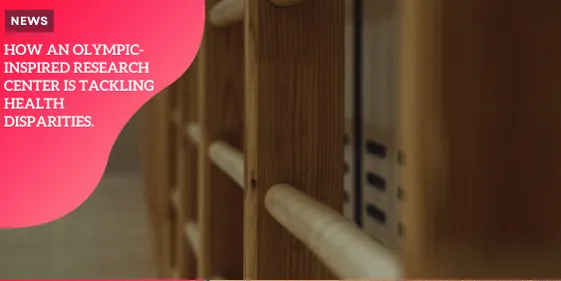How an Olympic-inspired research center is tackling health disparities.

Introduction
In a newly transformed industrial section of Sheffield, researchers from Sheffield Hallam University, renowned for their work with some of the country’s top athletes, are now addressing significant health disparities in South Yorkshire.
This shift in focus represents a remarkable evolution from their previous role of enhancing athletic performance to improving public health.
The heart of this transformation lies in Darnall, a suburb in Sheffield’s east, previously known as the hub of the “Steel City” due to its historical significance in the steel industry.
Today, Darnall is at the forefront of research and innovation, tackling some of the most pressing health challenges facing the local community and the broader region.
A Historic Transformation
Darnall’s transition from an industrial powerhouse to a center of health research and sports innovation is nothing short of remarkable.
Once known for producing stainless steel, this area now hosts the Sheffield Olympic Legacy Park and the English Institute of Sport Sheffield.
These facilities, where athletes like Jessica Ennis-Hill and Anthony Joshua trained for the London 2012 Olympics, symbolize the area’s evolution.
The park and its surrounding infrastructure represent a physical transformation that includes research centers, sporting venues, and community facilities coexisting harmoniously.
The Research Hub
At the heart of this transformation is Sheffield Hallam University’s Advanced Wellbeing Research Centre (AWRC), supported by a £14 million grant from the Department of Health and Social Care.
This state-of-the-art facility, which opened in January 2020, is dedicated to improving public health.
The AWRC collaborates with health and technology sector partners, charities, and community groups to address health disparities.
According to Oliver Coppard, the mayor of South Yorkshire, the research conducted at the AWRC is pivotal to his mission of making South Yorkshire the healthiest region in the country.
Addressing Health Inequalities
The challenge is immense. The gap in healthy life expectancy between the wealthiest and poorest parts of South Yorkshire is a staggering 20 years.
Nationally, this disparity is also evident.
A recent report based on data collected between 2011 and 2019 revealed that approximately one million people in England died prematurely due to socioeconomic inequalities.
These statistics underscore the urgency of the work being undertaken at the AWRC.
Promoting Physical Activity
Many projects at the AWRC aim to promote physical activity as a means to improve health outcomes.
One notable initiative, funded by Yorkshire Cancer Research, focuses on prehabilitation for cancer patients.
This approach involves enhancing patients’ health and fitness before they undergo surgery or treatments like chemotherapy and radiotherapy.
Research has shown that cancer patients in better physical condition tend to recover more effectively and benefit more from their treatments.
Social Prescribing and Community Health
The AWRC is also collaborating with Darnall Well Being, a local charity, on social prescribing projects.
Social prescribing connects individuals with community activities and support services to improve their physical and mental health.
These initiatives target marginalized communities dealing with chronic long-term conditions such as long Covid, frailty, and dementia.
By understanding how social prescribing can enhance health outcomes, researchers aim to develop scalable solutions that can be implemented across the region and beyond.
Leveraging Athletic Technology
Interestingly, some of the technologies that helped athletes achieve Olympic glory are now being repurposed to address public health issues.
For instance, Dr. Alice Bullas, a researcher at the AWRC, is using 3D scanners—originally designed to assess the muscle and fat composition of professional athletes—to precisely measure individual body shapes.
This innovative approach aims to overcome the limitations of body mass index (BMI) in assessing obesity, providing a more accurate understanding of body composition in children and adults.
Digital Healthcare Innovations
One of the most exciting developments at the AWRC is a collaboration with Google and the University of Sheffield to establish a pioneering digital healthcare hub in South Yorkshire.
Launched last year, this initiative focuses on addressing healthcare inequalities through preventative medicine.
As part of an ongoing trial, populations across the region are equipped with wearable devices that monitor their health over time.
The data collected will enable scientists to understand how best to support individuals in becoming fitter and healthier.
Future Implications
The insights gained from these trials are expected to be available within the next five years.
Both Coppard and Duncan are optimistic that this research will provide valuable insights to address health disparities on a national scale.
Moreover, the findings could help alleviate some of the ongoing pressures on the NHS by informing preventative health strategies that reduce the incidence of chronic illnesses.
Conclusion
In conclusion, the transformation of Darnall from an industrial hub to a center of health research and innovation is a testament to the region’s resilience and adaptability.
The work being conducted at the Sheffield Olympic Legacy Park and the AWRC is not only addressing health disparities in South Yorkshire but also setting a precedent for how communities can leverage research and technology to improve public health.
Through collaborative efforts, innovative research, and a commitment to addressing inequalities, Sheffield Hallam University and its partners are paving the way for a healthier future for all.





